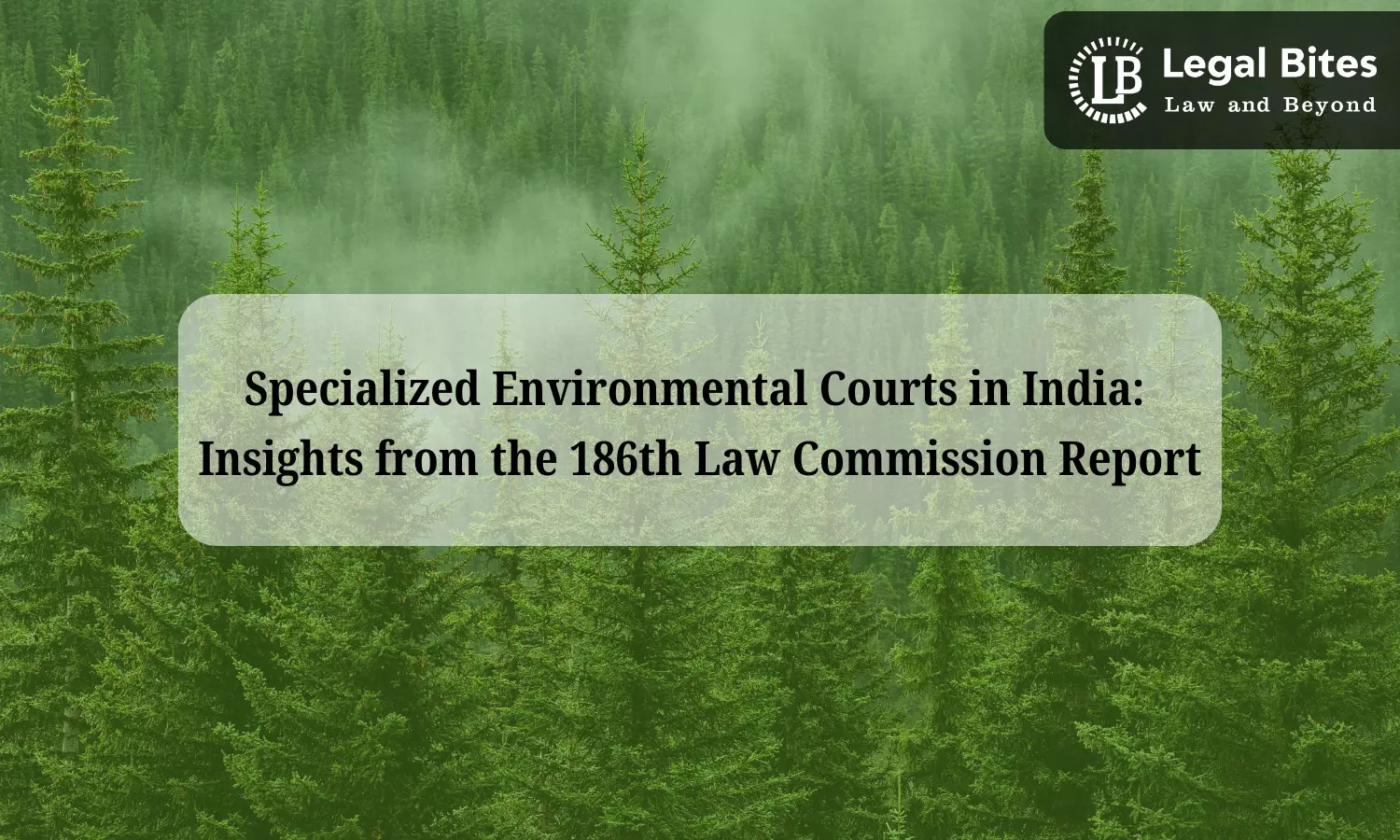Specialized Environmental Courts in India: Insights from the 186th Law Commission Report
This article reviews the 186th Report's recommendations, explores the need for specialized environmental courts, and assesses progress made.

Environmental degradation is one of the most pressing concerns facing modern India. Rapid industrialization, urbanization, and population growth have led to increasing stress on natural resources and environmental quality. While the Constitution of India recognizes the importance of environmental protection under Articles 48A and 51A(g), the judicial system is often overburdened and ill-equipped to handle the growing complexity of environmental litigation. It is in this context that the 186th Report of the Law Commission of India (2003) proposed the establishment of specialized Environmental Courts.
Background: Environmental Governance in India
Environmental governance in India is currently managed through a combination of legislative enactments and judicial interventions. Key statutes include:
- The Environment (Protection) Act, 1986
- The Water (Prevention and Control of Pollution) Act, 1974
- The Air (Prevention and Control of Pollution) Act, 1981
- The Forest (Conservation) Act, 1980
- The Biological Diversity Act, 2002
In addition, the Indian judiciary has played a transformative role through Public Interest Litigation (PIL), establishing doctrines such as the Polluter Pays Principle, Precautionary Principle, and Sustainable Development. However, generalist courts often face difficulty in dealing with complex scientific, ecological, and technical issues that are intrinsic to environmental matters.
186th Law Commission Report: An Overview
Published in 2003, the 186th Report of the Law Commission of India, titled "Proposal to Constitute Environmental Courts", emphasized the need for a specialized adjudicatory mechanism for environmental matters. The key objectives were:
- Ensuring effective, expeditious, and expert adjudication of environmental disputes.
- Reducing the burden on High Courts and the Supreme Court.
- Facilitating a multidisciplinary approach by including technical experts in environmental science.
Key Recommendations
Establishment of Environmental Courts
The Report recommended the establishment of Environmental Courts in every state as a part of the judicial system. These courts would be empowered to hear civil cases related to environmental issues.
Composition of the Court
Each court was proposed to consist of a judicial member (a serving or retired High Court judge) and two technical members with expertise in environmental science or technology.
Jurisdiction and Powers
The courts were to have original and appellate jurisdiction over environmental matters, including appeals from decisions of Pollution Control Boards and other regulatory authorities.
Exclusion of Writ Jurisdiction
The Report suggested that while the jurisdiction of the Supreme Court under Article 32 and the High Courts under Article 226 cannot be ousted, the need for environmental PILs would reduce with effective lower-level adjudication.
Procedural Flexibility
The proposed courts were to follow less formal and more flexible procedures with powers to appoint independent experts and conduct field inspections.
Integration with Existing Institutions
Coordination with statutory authorities like the Central Pollution Control Board (CPCB) and State Pollution Control Boards (SPCBs) was proposed.
Rationale for Specialized Environmental Courts
1. Scientific and Technical Complexity
Environmental cases often involve intricate scientific data, ecological modeling, and long-term environmental impact assessments. Generalist judges may not have the requisite training to understand and interpret such material accurately.
2. Multidisciplinary Adjudication
The involvement of technical members in proposed courts was meant to ensure that decisions are informed not just by law, but also by science, economics, and social implications.
3. Delay and Inefficiency
Environmental litigation often suffers from delays, partly because these cases compete with other civil and criminal matters in regular courts. Specialized courts could streamline environmental adjudication.
4. Public Health and Safety
Environmental degradation directly affects public health and community well-being. Quick and effective resolution of environmental disputes is thus a public necessity.
5. Compliance with International Commitments
India is a signatory to several international environmental conventions such as the Rio Declaration, Stockholm Declaration, and Paris Agreement. Establishing specialized courts would demonstrate India’s commitment to strengthening environmental governance.
Judicial Support and Recognition
Indian judiciary has itself acknowledged the need for specialized courts. In A.P. Pollution Control Board v. Prof. M.V. Nayudu (1999) 2 SCC 718, the Supreme Court observed that:
“Environmental cases involve assessment of scientific data and require a proper understanding of environmental science. Hence, a need is felt for setting up environmental courts manned by legally and technically qualified personnel.”
In Indian Council for Enviro-Legal Action v. Union of India (1996) 3 SCC 212, the Court emphasized the inadequacy of the existing institutional framework and called for reforms to ensure better enforcement of environmental laws.
National Green Tribunal: Response to the 186th Report
The recommendations of the 186th Law Commission Report found legislative manifestation in the enactment of the National Green Tribunal Act, 2010. The National Green Tribunal (NGT) was established under this Act as a specialized body to handle environmental disputes involving multidisciplinary issues.
Structure and Powers of NGT
- Composition: A judicial member (former SC/HC judge) and expert members from environmental sciences.
- Jurisdiction: Civil cases relating to substantial environmental questions and enforcement of environmental laws.
- Powers: The NGT can provide relief, compensation, and restitution for environmental damage. It has both original and appellate jurisdiction.
Achievements
- The NGT has played a significant role in addressing a wide range of environmental issues, including air pollution in Delhi, illegal mining, water pollution, and waste management.
- It has provided a forum for faster disposal of environmental disputes compared to regular courts.
Limitations
- The NGT does not have criminal jurisdiction under the environment-related Acts.
- It faces resource constraints and limited benches across India, leading to accessibility issues.
- Its orders are sometimes challenged and stayed by High Courts, leading to inconsistency and delay.
Continued Relevance of the 186th Report
Despite the formation of the NGT, several aspects of the 186th Law Commission Report remain unimplemented or only partially addressed:
- State-Level Environmental Courts: The NGT operates at the national level with regional benches, but state-level courts, as recommended by the Report, are yet to be established comprehensively.
- Integration with Civil and Criminal Jurisdiction: The NGT does not have the power to try criminal violations of environmental laws. A comprehensive court system with criminal, civil, and appellate jurisdiction is still needed.
- Accessibility and Inclusion: While the NGT is a step forward, it is not easily accessible to citizens in remote or rural areas. The Report’s vision of decentralized, state-level courts could help bridge this gap.
Comparative Models from Other Jurisdictions
1. Australia
The Land and Environment Court of New South Wales is a model environmental court with both judicial and scientific expertise. It has broad jurisdiction over environmental planning, civil enforcement, and criminal prosecutions.
2. Sweden
Sweden has Environmental Courts that are part of its judicial structure and include technical judges with environmental expertise.
3. Philippines
The Philippines has introduced green benches in regular courts with judges trained in environmental law. These international models highlight the importance of specialized training, integrated jurisdiction, and accessibility.
Challenges in Establishing Specialized Environmental Courts
- Resource and Infrastructure Limitations: Establishing a new cadre of courts requires substantial investment in training, staffing, and infrastructure.
- Coordination with Regulatory Bodies: Ensuring seamless interaction between courts and bodies like CPCB, SPCBs, and the Ministry of Environment is crucial.
- Resistance from Legal Community: There may be resistance to moving jurisdiction from generalist courts to specialized forums.
- Uniformity of Jurisprudence: Ensuring consistency in environmental jurisprudence across various specialized courts poses a challenge.
Recommendations
- Expansion of NGT Benches: More regional and state benches of the NGT should be established for better outreach and access.
- Training and Capacity Building: Judges, lawyers, and environmental regulators should undergo continuous training in environmental law and science.
- Integration with Local Dispute Resolution: Environmental courts should be linked with local self-governance institutions (Panchayats, Municipalities) for grassroots-level participation.
- Legislative Reforms: Amendments in key environmental laws to enable criminal jurisdiction for specialized courts are needed.
- Public Awareness and Legal Aid: Citizens need greater awareness and access to environmental justice mechanisms, supported by legal aid and community advocacy.
Conclusion
The 186th Law Commission Report remains a visionary document that recognized the urgent need for a specialized adjudicatory mechanism to address environmental challenges in India. While the establishment of the NGT has partially fulfilled this vision, much remains to be done. Decentralized, integrated, and technically proficient environmental courts across all states, as proposed by the Report, are vital for ensuring that environmental justice is not just a constitutional promise but a practical reality. In an era marked by climate change and ecological crises, India’s legal infrastructure must evolve to meet the demands of environmental governance with expertise, efficiency, and empathy.
References
[1] Law Commission of India, 186th Report on Proposal to Constitute Environmental Courts (2003)
[2] National Green Tribunal Act, 2010
[3] A.P. Pollution Control Board v. Prof. M.V. Nayudu (1999) 2 SCC 718.
[4] Indian Council for Enviro-Legal Action v. Union of India (1996) 3 SCC 212.
[5] Constitution of India, Articles 48A and 51A(g)
[6] Gitanjali Nain Gill, "Environmental Justice in India: The National Green Tribunal and Expert Members," Transnational Environmental Law, Vol. 5(1), 2016

